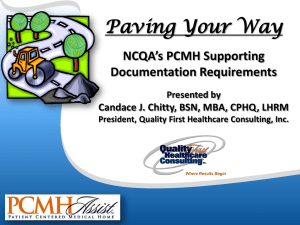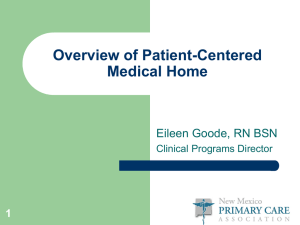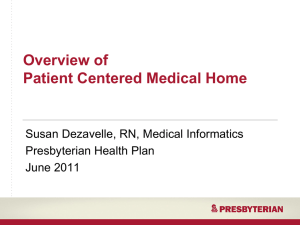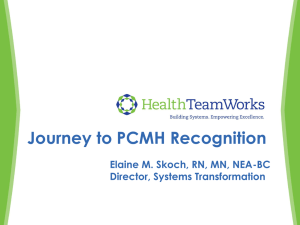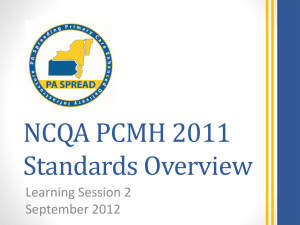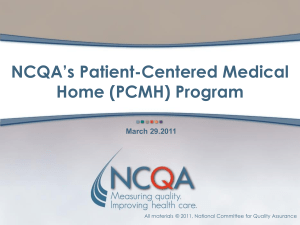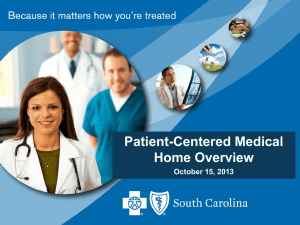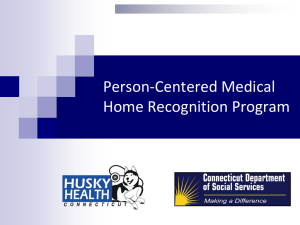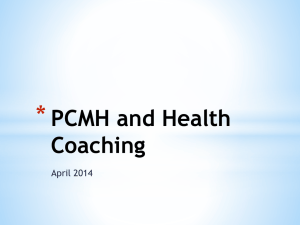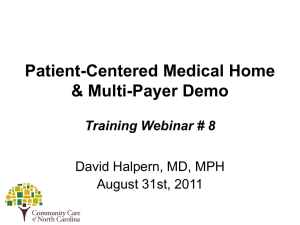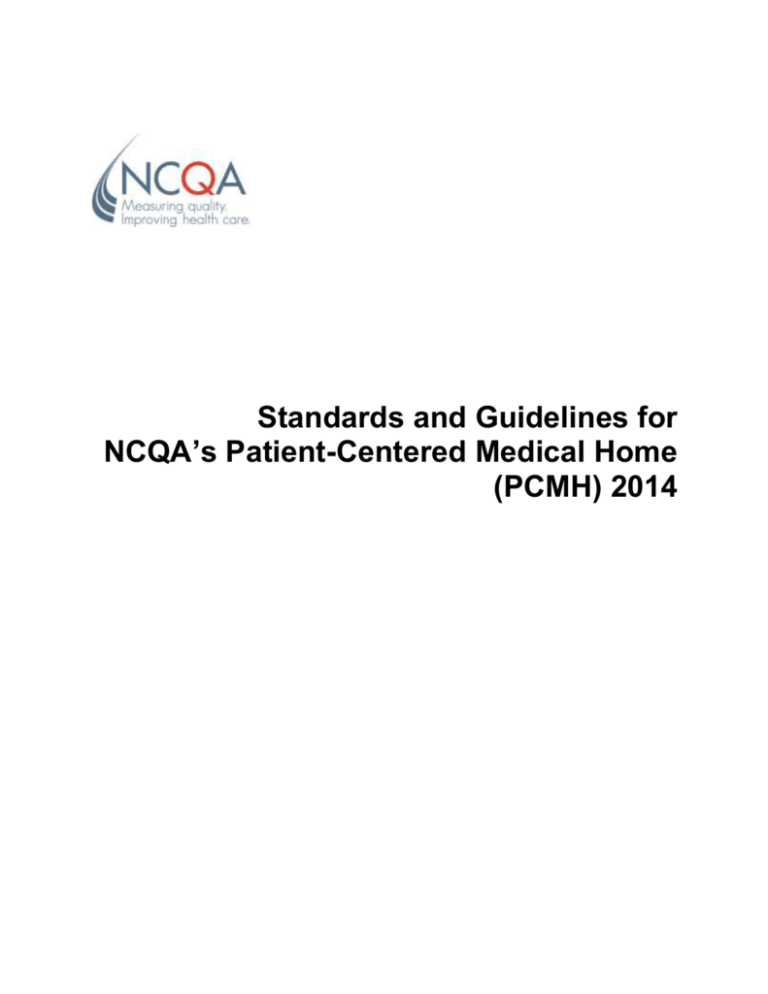
Standards and Guidelines for
NCQA’s Patient-Centered Medical Home
(PCMH) 2014
No part of this publication may be reproduced or transmitted in any form or by any means, electronic or mechanical,
including photocopy, recording, or any information storage and retrieval system, without the written permission of
NCQA.
© 2014 by the National Committee for Quality Assurance (NCQA)
1100 13th Street, NW, Suite 1000
Washington, DC 20005
All rights reserved.
NCQA Customer Support: 888-275-7585.
Acknowledgments
The PCMH Advisory Committee
NCQA began planning for the next version of the PCMH standards shortly after the 2011 standards were
released. From the 2011 release date, we solicited, received and catalogued suggestions for future
modifications. Early in 2013, we assembled the PCMH Advisory Committee, a diverse, 21-member
committee composed of representatives from practices, medical associations, physician groups, health
plans and consumer and employer groups. The committee met throughout 2013 to discuss and analyze
draft standards, PCMH data analysis and public comment results.
The committee shaped updates to accomplish the following in PCMH 2014:
1. Emphasize team-based care.
2. Focus care management on high-need populations.
3. Set the bar higher and align quality improvement activities with the Triple Aim.1
4. Align with Meaningful Use Stage 2 (MU2).
5. Further integration of behavioral healthcare.
The importance of this committee cannot be overstated. Its members gave their time, energy, enthusiasm
and a willingness to hear and compromise on opposing perspectives. The PCMH 2014 standards are a
reflection of their hard work and collaboration.
Randy Curnow, MD, MBA, FACP Chair
Vice President for Medical Affairs, Mercy Health
Physicians
Daniel Miller, MD
Hudson River HealthCare Inc.
Bruce Bagley, MD
American Academy of Family Physicians
Marci Nielsen, PhD, MPH
The Patient-Centered Primary Care
Collaborative
Michael Barr, MD, MBA, FACP
American College of Physicians
Lee Partridge
National Partnership for Women and Families
Susan Edgeman-Levitan, PA
Stoeckle Center for Primary Care Innovation,
Massachusetts General Hospital
Jacob Reider, MD
Office of the National Coordinator for Health
Information Technology
Foster Gesten, MD
New York State Department of Health
Kaitlyn Roe
Fuse Health Strategies, LLC
Ralph Gonzales, MD, MSPH
New York State Department of Health
Julie Schilz, BSN, MBA
WellPoint
Marjie Harbrecht, MD
HealthTeam Works
Xavier Sevilla, MD, FAAP
American Academy of Pediatrics
Kathleen Jaeger, JD
National Association of Chain Drug Stores
Lisa Dulsky Watkins, MD
Vermont Blueprint for Health
Regina Julian, MHA, MBA, FACHE
Office of the Assistant Secretary of Defense for Health
Affairs/TRICARE Management Activity
Audrey Whetsell, CPHIT, MA
Resource Partners
Donald Liss, MD
Independence Blue Cross
Kimberly Williams, LMSW
Mental Health Association of New York City
Sean Lyon, MSN, APRN, FNP-BC
Life Long Care, PLLC
1http://www.ihi.org/Engage/Initiatives/TripleAim/Pages/default.aspx
March 24, 2014
NCQA’s Patient-Centered Medical Home (PCMH) 2014
Table of Contents
Table of Contents
NCQA’s Patient-Centered Medical Home 2014—Overview ......................................................................... 1
Goals for PCMH and Beyond ................................................................................................................. 2
NCQA PCMH Evolution .......................................................................................................................... 3
PCMH 2014 ............................................................................................................................................ 4
Development .................................................................................................................................... 4
The Consumer Perspective ............................................................................................................. 5
Public Comment ............................................................................................................................... 5
The Standards .................................................................................................................................. 5
The Must-Pass Elements ................................................................................................................. 5
Recognition Levels and Point Requirements ................................................................................... 6
Initial Recognition vs. Renewal ........................................................................................................ 6
Optional Recognition for Use of Standardized Patient Experience Survey ..................................... 6
Resources ..................................................................................................................................................... 7
Policies and Procedures
Section 1: Eligibility and the Application Process
Definitions ...................................................................................................................................... 11
Eligibility ......................................................................................................................................... 11
Fee Schedule Information .............................................................................................................. 12
Recognition Program Partners in Quality....................................................................................... 12
Start-to-Finish Pathway .................................................................................................................. 13
The PCMH 2014 Online Application Process ................................................................................ 13
Application Components .......................................................................................................... 13
The PCMH 2014 Multi-Site Application.......................................................................................... 14
Determine Multi-Site Eligibility ................................................................................................. 14
Multi-Site Corporate and Site-Specific Survey Tool Submission ............................................ 15
Practice Readiness Evaluation ...................................................................................................... 15
Complete the Application ............................................................................................................... 15
Prepare and Submit the ISS Survey Tool ...................................................................................... 16
Section 2: The Recognition Process
NCQA Survey Tool Review ............................................................................................................ 18
The Review .............................................................................................................................. 18
The Audit ................................................................................................................................. 18
PCMH 2014 Standards .................................................................................................................. 19
A Standard’s Structure ................................................................................................................... 19
Scoring Guidelines ......................................................................................................................... 20
Final Decision and Recognition Levels .......................................................................................... 21
Section 3: Additional Information
Add-On Survey............................................................................................................................... 22
Renewing Recognition ................................................................................................................... 22
Reconsideration ............................................................................................................................. 22
Applicant Obligations ..................................................................................................................... 23
Complaint Review Process ............................................................................................................ 23
Discretionary Survey ...................................................................................................................... 24
Suspension of Recognition ............................................................................................................ 24
Revoking Decisions ........................................................................................................................ 24
Mergers, Acquisitions and Consolidations ..................................................................................... 25
Revisions to Policies and Procedures ............................................................................................ 25
Disclaimer ...................................................................................................................................... 25
NCQA’s Patient-Centered Medical Home (PCMH) 2014
March 24, 2014
Table of Contents
PCMH 2014 Standards
PCMH 1: Patient-Centered Access ...................................................................................................... 29
PCMH 2: Team-Based Care................................................................................................................. 37
PCMH 3: Population Health Management ........................................................................................... 46
PCMH 4: Care Management and Support ........................................................................................... 60
PCMH 5: Care Coordination and Care Transitions .............................................................................. 71
PCMH 6: Performance Measurement and Quality Improvement ......................................................... 79
Appendices
Appendix 1: PCMH 2014 Scoring
Appendix 2: NCQA PCMH 2014 and CMS Stage 2 Meaningful Use Requirements
Appendix 3: PCMH 2014 Glossary
Appendix 4: PCMH 2011–PCMH 2014 Crosswalk
Appendix 5: PCSP-PCMH 2014 Crosswalk
March 24, 2014
NCQA’s Patient-Centered Medical Home (PCMH) 2014
NCQA’s Patient-Centered Medical Home (PCMH) 2014
March 24, 2014
Overview
NCQA’s Patient-Centered Medical Home (PCMH) 2014
March 24, 2014
Overview
1
NCQA’s Patient-Centered Medical Home 2014
Patient-centered medical homes (PCMH) are transforming primary care practices into what patients want:
a focus on patients themselves and their health care needs. Medical homes are the foundation for a
health care system that gives more value by achieving the “Triple Aim” of better quality, experience and
cost. This is the overview to our vision for achieving that goal; it chronicles the PCMH evolution to date,
the challenges that lie ahead and potential solutions to those challenges—some already underway, some
yet to be developed.
As of February 2014, 7,066 practices were recognized as PCMHs by NCQA, which has the nation’s
largest PCMH program. To earn NCQA Recognition, practices must meet rigorous standards for
addressing patient needs; for example, offering access after office hours and online so patients get care
and advice, where and when they need it. PCMHs get to know patients in long-term partnerships, rather
than through hurried, sporadic visits. They make treatment decisions with their patients, based on patient
preference. They help patients become engaged in their own healthy behaviors and health care.
Everyone in the practice—from clinicians to front desk staff—works as a team to coordinate care from
other providers and community resources. This maximizes efficiency by ensuring that highly trained
clinicians are not performing tasks that can be accomplished by other staff, and helps avoid costly and
preventable complications and emergencies through a focus on prevention and managing chronic
conditions.
A growing body of evidence documents the many benefits of medical homes, including better quality,
patient experience, continuity, prevention and disease management. Studies show lower costs from
reduced emergency department (ED) visits and hospital admissions, reduced income-based disparities in
care and lower rates of provider burnout.
PCMHs’ power to improve the quality, cost and experience of primary care, however, only begins the
broad change our health care system needs. Other providers and facilities must build on PCMH
foundations to establish patient-centered care throughout health care. This is beginning in the patientcentered specialty practices (PCSP), which help specialists become part of medical neighborhoods to
improve quality and access.
Adoption of patient-centered strategies is also underway in many emerging accountable care
organizations (ACO). ACOs build on a solid PCMH foundation to coordinate doctors, hospitals,
pharmacies, other providers and community resources and make sure people get all the care they need.
They share savings from reduced waste and inefficiency if they also improve quality.
March 24, 2014
NCQA’s Patient-Centered Medical Home (PCMH) 2014
2
Overview
Goals for PCMH and Beyond
Primary care clinicians will deliver safe, effective and efficient care that is well coordinated across
the medical neighborhood and optimizes the patient experience.
Primary care will be the foundation of a high-value health care system that provides whole-person
care at the first contact. Everyone in primary care practices—from physicians and advanced
practice nurses to medical assistants and frontline staff—should practice to the highest level of
their training and license in teams, to support better access, self-care and care coordination.
PCMHs will show the entire health care system what patient-centered care looks like: care that is
“respectful of and responsive to individual patient preferences, needs, and values, and ensures that
patient values guide all clinical decisions.” Individuals and families get help to be actively engaged
in their own healthy behaviors and health care, and in decisions about their care.
PCMHs will revitalize the “joy of practice” in primary care, making it more appealing and satisfying.
This vision is becoming reality in many parts of the country. For example, in Vermont, NCQA-Recognized
PCMHs are being widely adopted as the foundation for the state’s “Blueprint for Health.” Purchasers and
policymakers there are engaging a broader set of providers—specialists, hospital systems and community
providers of social and long-term services and supports—to align incentives for better value.
The medical neighborhood. Although primary care is the foundation for delivery system transformation,
PCMHs cannot change the entire system alone. Data sharing among primary care, specialists, hospitals
and other providers is needed to maximize coordination and management. Our current payment system
drives greater use of services, especially high-volume services for hospitals and many specialists.
Primary-care spending is low and a small share, compared with other providers, which limits access to
capital for information technology and other systems to support outreach, patient engagement and
analysis. Other parts of the system must also have strong incentives to change if we are to realize better
outcomes.
Patient-centered specialty practices. Specialty-care clinicians provide many services and many
patients seek specialists’ care directly without primary care consultation. For patients with certain chronic
conditions, specialists serve as primary-care providers for extended periods. Creating better ways for
information to flow effectively among primary-care clinicians and specialists is critical for care coordination
and reducing duplicate care. In 2013 NCQA launched the Patient-Centered Specialty Practice (PCSP)
program to recognize specialists that use systems and processes needed to support patient-centered
care, including strong communication with other providers.
Accountable care organizations. ACOs are bringing communities of doctors, hospitals and other
providers together to improve outcomes and lower costs. They share in savings if they can show
improved quality. Medicare and other insurers now support these “shared savings” opportunities. PCMHs
provide the solid foundation that ACOs must build on to ensure quality, patient-centered care. ACOs can
help build and redistribute funding to primary care, to develop the critically important PCMH infrastructure.
Behavioral healthcare. This is a key focus for better integration, particularly in Medicaid, where many
high-cost enrollees have behavioral conditions. Integrating behavioral healthcare poses additional
challenges from heightened privacy concerns, culture differences and patients’ tendency to avoid primary
care. Unaddressed behavioral conditions can exacerbate physical conditions, which increases disability
and cost. Medicaid “health home” initiatives are now working to bring primary care into behavioral health
practices or to provide behavioral healthcare expertise in primary care settings. Some states use NCQA’s
PCMH and PCSP standards to define health home capabilities.
Public health: Bringing complementary strengths of public health and primary care together has great
potential. Some public health providers—school-based, HIV and community health centers—provide
primary care and can be PCMHs. The Health Resources and Services Administration is helping
community health centers become PCMHs. North Carolina is using public health staff to visit at-risk
pregnant women in their homes, to help primary care providers engage these patients and get them
NCQA’s Patient-Centered Medical Home (PCMH) 2014
March 24, 2014
Overview
3
better prenatal care. Vermont is connecting its PCMHs and providers of long-term services and supports,
to deliver much-needed information and care coordination to patients. Going forward, it will be critical to
help all PCMHs connect with community resources that can also improve health.
Work site, retail clinics and pharmacies. Work-site clinics increasingly serve as employees’ main
primary care setting. Retail clinics that treat minor problems in drug stores and other convenient settings
are expanding to address wellness, health promotion and chronic care management. Many refer patients
back to community primary-care clinicians for follow-up. Pharmacies are also taking on new roles with
immunizations, health and wellness screenings, adherence and other medication management services.
As these options gain in popularity and scope, it becomes increasingly important that they share
information with PCMHs.
NCQA PCMH Evolution
The American Academy of Pediatrics introduced the medical home concept in 1967. A generation later, in
2004 the specialty of family medicine called for all patients to have a “personal medical home.” In 2003
NCQA launched Physician Practice Connections, a PCMH precursor program. In 2007, leading primary
care associations released the Joint PCMH Principles. In 2008, NCQA launched the first PCMH
Recognition program, with updates to raise the bar in 2011 and 2014. NCQA’s PCMH program is the
largest, with over 34,600 clinicians at 6,800 sites as of 12/31/2013 – about 10 percent of all primary care
clinicians.
Year
2003
Version
Physician Practice
Connections (PPC)
2008
Physician Practice
Connections—PatientCentered Medical Home
(PPC-PCMH)
2011
PCMH 2011
2014
PCMH 2014
Elements of the Program
This PCMH precursor recognized use of systematic processes and health IT to:
Know and use patient history.
Follow up with patients and other providers.
Manage patient populations and use evidence-based care.
Employ electronic tools to prevent medical errors.
The first PCMH model implemented the Joint Principles, emphasizing:
Ongoing relationship with personal physician.
Team-based care.
Whole-person orientation.
Care coordination and integration.
Focus on quality, safety and enhanced access.
Explicitly incorporated health information technology Meaningful Use criteria.
Added content and examples for pediatric practices on parental decision making, ageappropriate immunizations, teen privacy and other issues.
Added voluntary distinction for practices that participate in the CAHPS PCMH survey of
patient experience and submit data to NCQA.
Added content and examples for behavioral healthcare.
More integration of behavioral healthcare.
Additional emphasis on team-based care.
Focus care management for high-need populations.
Encourage involvement of patients and families in QI activities
Alignment of QI activities with the Triple Aim: improved quality, cost and experience of
care.
Alignment with health information technology Meaningful Use Stage 2.
Broad support. Many public- and private-sector initiatives support PCMH transformation. The
Department of Defense is working to transform its primary care practices into NCQA PCMHs. The
Department of Health and Human Services is helping hundreds of community health centers and
Federally Qualified Health Centers to become PCMHs. The Office of the National Coordinator for Health
Information Technology’s Regional Extension Centers provide technical assistance to practices.
Congress is advancing legislation to move Medicare beyond demonstration programs in selected states
March 24, 2014
NCQA’s Patient-Centered Medical Home (PCMH) 2014
4
Overview
to support PCMHs nationwide, with new payments to reward value and non-face-to-face chronic care
management services. In addition, states and private insurers have programs in place to support PCMHs
in more than three dozen states.
Practices of all sizes earn NCQA recognition. Most have fewer than eight clinicians; more than a third
have one or two. More than 75 percent of NCQA PCMHs have achieved Level 3 Recognition,
representing the most advanced capabilities.
PCMH penetration is greatest in states that provide the most technical and financial support in making the
transformation. In New York State, for example, 25 percent of all primary-care practitioners are in NCQARecognized PCMHs.
Attributes for success. There are many paths to becoming successful PCMHs—they do not all look
alike and generally consider local circumstances and preferences. NCQA has identified several attributes
that contribute to PCMH success:
Financial or technical assistance, or both, to help create and sustain the transformation. Practices
value practical examples and support for meeting requirements, and worry about maintaining their
financial viability.
Organization leadership, a team-based approach, health information technology and delegating
self-management education and proactive care reminders to nonphysician team members.
Involving patients and families in practice improvement efforts through advisory committees,
ombudsmen or navigators.
A systems approach to QI that results in data, standard measurements, technical assistance,
leadership and personnel.
PCMH 2014
Development
Pediatricians performed the early work on the “medical home” concept, which focused on care of children
with special needs. The concept was developed further by a collaboration of primary care physician
societies* and was articulated in the 2007 Joint Principles of the Patient-Centered Medical Home and
reflected in NCQA’s 2008 Physician Practice Connections ®—Patient-Centered Medical Home™ (PPC®PCMH™) standards. These Joint Principles continued as the foundation of the NCQA PCMH 2011
standards.
The PCMH 2014 standards will move the transformation of primary care practices forward, while ensuring
that recognition is within reach of practices of varying sizes, configurations (e.g., solo, multi-site,
community health center), electronic capabilities, populations served and locations (e.g., urban, rural).
Standards development was a rigorous process that included significant research; input from an
engaged, multi-stakeholder advisory committee and from many others; results of an open public comment
period; and interviews with NCQA-Recognized practices.
*The American College of Physicians (ACP), the American Academy of Family Physicians (AAFP), the American
Academy of Pediatrics (AAP) and the American Osteopathic Association (AOA).
NCQA’s Patient-Centered Medical Home (PCMH) 2014
March 24, 2014
Overview
5
The Consumer Perspective
In developing the PCMH 2014 standards, we were guided by a strong consensus that we expand the
patient-centered perspective. To ensure that we captured this vantage point, the advisory committee
included a patient partner, consumer organization representatives and researchers working on related
patient-centered areas, and we encouraged consumer participation during the public comment process.
Public Comment
We posted the draft standards on the NCQA Web site and solicited comments from a wide group of
stakeholders. We received more than 1,600 comments from more than 150 respondents, including health
care providers, health plans, consumer groups and government agencies. There was a high degree
(nearly 90 percent of comments received) of support for the proposed standards, especially the increased
emphasis on patient-centered, team-based care coordinated across the health care system.
In addition to the formal public comment period, we received useful suggestions from others for further
revisions and changes, which we incorporated into the final version of the standards after review by our
stakeholder advisory committee, NCQA’s Clinical Programs Committee and the NCQA Board of
Directors.
The Standards
The PCMH 2014 program’s six standards align with the core components of primary care.
1. PCMH 1: Patient-Centered Access.
2. PCMH 2: Team-Based Care.
3. PCMH 3: Population Health Management.
4. PCMH 4: Care Management and Support.
5. PCMH 5: Care Coordination and Care Transitions.
6. PCMH 6: Performance Measurement and Quality Improvement.
The Must-Pass Elements
Six must-pass elements are considered essential to the patient-centered medical home, and are required
for practices at all recognition levels. Practices must achieve a score of 50% or higher on must-pass
elements:
1. PCMH 1, Element A: Patient-Centered Appointment Access.
2. PCMH 2, Element D: The Practice Team.
3. PCMH 3, Element D: Use Data for Population Management.
4. PCMH 4, Element B: Care Planning and Self-Care Support.
5. PCMH 5, Element B: Referral Tracking and Follow-Up.
6. PCMH 6, Element D: Implement Continuous Quality Improvement.
March 24, 2014
NCQA’s Patient-Centered Medical Home (PCMH) 2014
6
Overview
Recognition Levels and Point Requirements
There are three levels of NCQA PCMH Recognition; each level reflects the degree to which a practice
meets the requirements of the elements and factors that comprise the standards. For each element’s
requirements, NCQA provides examples and requires specific documentation.
The NCQA Recognition levels allow practices with a range of capabilities and sophistication to meet the
standards’ requirements successfully. The point allocation for the three levels is as follows.
Level 1: 35–59 points and all 6 must-pass elements.
Level 2: 60–84 points and all 6 must-pass elements.
Level 3: 85–100 points and all 6 must-pass elements.
Initial Recognition vs. Renewal
To acknowledge that practices with current NCQA Level 2 or Level 3 Recognition have taken steps
toward practice redesign and have systems in place that enabled their existing recognition level, NCQA
offers a streamlined process for renewal through reduced documentation requirements. Practices that
satisfactorily demonstrated basic medical home transformation can focus on more advanced aspects of
redesign for their renewal applications.
Note: Even though some elements do not require a practice to submit documentation, the practice must
be able to produce documentation if it is selected for audit.
Optional Distinction for Use of Standardized Patient Experience Survey
NCQA offers special acknowledgment for practices reporting results from a standardized patient
experience survey. This option requires practices to use the Medical Home version of the CAHPS
Clinician and Group Survey (CAHPS PCMH). Practices can earn distinction for collecting data through a
certified vendor using the standardized survey, following the defined methods and reporting the results to
NCQA.
Table 1: Summary of NCQA PCMH 2014 Standards
Standard
Summary of Requirements
PCMH 1: Patient-Centered Access
The practice provides 24/7 access to team-based care for both routine
and urgent needs of patients/families/caregivers.
PCMH 2: Team-based Care
The practice provides continuity of care using culturally and
linguistically appropriate, team-based approaches.
PCMH 3: Population Health Management
The practice provides evidence-based decision support and proactive
care reminders based on complete patient information, health
assessment and clinical data.
PCMH 4: Care Management and Support
The practice systematically identifies individual patients and plans,
manages and coordinates care, based on need.
PCMH 5: Care Coordination and Care
Transitions
The practice systematically tracks tests and coordinates care across
specialty care, facility-based care and community organizations.
PCMH 6: Performance Measurement and
Quality Improvement
The practice uses performance data to identify opportunities for
improvement and acts to improve clinical quality, efficiency and patient
experience.
NCQA’s Patient-Centered Medical Home (PCMH) 2014
March 24, 2014
Overview
7
Table 2: Integration of PCMH 2014 Development Goals Into Standards
Development Goal
1. Emphasis on teambased care.
2. Focus care
management on
high-need
populations.
3. Higher bar and
alignment of QI
activities with the
Triple Aim.
4. Align with
Meaningful Use
Stage 2 (MU2)
5. Further integration of
behavioral healthcare.
Additional Details
PCMH 2, Element D: Is now a must-pass element.
Team-focused elements moved to the new PCMH 2: Team-Based Care.
To highlight the importance of the patient as part of the team, incorporating patients in
improvement activities moved from PCMH 6 to PCMH 2.
Evidence-based decision support on an expanded range of topics (previously “three important
conditions”) moved to PCMH 3: Identify and Manage Populations.
– Element D: Use Data for Population Management: Practices proactively identify and
support patient populations using evidence-based guidelines related to preventive care
services, immunizations, chronic and acute care services, patients not recently seen by the
practice and medication monitoring or alerts.
– Element E: Implement Evidence-Based Decision Support: Practices use evidence-based
guidelines to implement point of care clinical decision support for mental health or
substance use disorders, a chronic medical condition, an acute condition, a condition
related to unhealthy behaviors, well child or adult care and overuse/appropriateness issues.
Practices consider patients who may benefit from care management and self-care support.
– PCMH 4, Element A: Identify Patients for Care Management: Practices establish a
systematic process and criteria to monitor the total percentage of the population identified
for care management. This requires considering behavioral health needs, patients
experiencing high cost/high utilization, poorly controlled or complex conditions, social
determinants of health and referrals by outside organizations (insurers, health systems,
ACO) and nominations from care team staff, family and caregivers.
Practices make efforts to improve in patient experience, cost and clinical quality.
Practices conduct activities at least annually and are subject to audit; renewing practices
continue to benefit from streamlined requirements for existing capabilities to focus on improving
outcomes and submit data from the previous 2 cycles of measurement.
All Meaningful Use Stage 2 requirements, both core and menu, are embedded within the
PCMH Standards and Guidelines.
MU2 is not a requirement for recognition. Practices without a certified EHR may submit
documentation to meet factors related to MU2.
Updated criteria delineate capability for treating unhealthy behaviors and conditions related to
mental health or substance abuse.
Practices communicate the scope of services available, including how behavioral concerns are
addressed.
PCMH 5, Element B: Referral Tracking and Follow-Up, factor 3: Practices maintain agreements
with behavioral healthcare providers. Factor 4 gives credit for integration of behavioral
healthcare into the practice site.
Resources
Perry R, et al. June 24, 2012. Examining the Impact of Continuity of Care on Medicare Payments in the
Medical Home Context. Presented at the AcademyHealth Annual Research Meeting, Orlando, FL.
http://www.academyhealth.org/files/2012/sunday/perry.pdf
Gabbay, R.A., et al. 2011. Multipayer patient-centered medical home implementation guided by the
chronic care model. Jt Comm J Qual Patient Saf. 37(6):265-73. http://ww.bailithealth.com/articles/062211_bhp_mpcmhi.pdf
Maeng, D.D., et al. 2011. Can a Patient-Centered Medical Home Lead to Better Patient Outcomes* The
Quality Implications of Geisinger’s Proven Health Navigator. Am J Med Qual. epub ahead of print Aug
18. http://ajm.sagepub.com/content/27/3/210.abstract?patientinform-links=yes&legid=spajm;27/3/210
DeVries, A., et al. 2012. Impact of Medical Homes on Quality Healthcare Utilization and Costs. AMJC.
http://www.ajmc.com/publications/issue/2012/2012-9-vol18-n9/Impact-of-Medical-Homes-on-QualityHealthcare-Utilization-and-Costs#sthash.vuXFYJRA.dpuf
Takach, M.. July 2011. Reinventing Medicaid: State Innovations To Qualify And Pay For Patient-Centered
Medical Homes Show Promising. Health Affairs.
http://content.healthaffairs.org/content/30/7/1325.abstract
March 24, 2014
NCQA’s Patient-Centered Medical Home (PCMH) 2014
8
Overview
Harbrecht, M., et al. September 2012. Colorado’s Patient-Centered Medical Home Pilot Met Numerous
Obstacles, Yet Saw Results Such as Reduced Hospital Admissions. Health Affairs.
http://content.healthaffairs.org/content/31/9/2010.abstract
Patient Centered Primary Care Collaborative. January 2014. The Medical Home's Impact on Cost &
Quality: An Annual Update of the Evidence, 2012-2013. www.pcpcc.org/resource/medical-homesimpact-cost-quality#sthash.EJoswJug.dpuf
Department of Vermont Health Access/Vermont Blueprint for Health.
http://hcr.vermont.gov/sites/hcr/files/pdfs/VTBlueprintforHealthAnnualReport2013.pdf
Berenson, J., et al. May 2012. Achieving Better Quality of Care for Low-Income Populations: The Role of
Health Insurance and the Medical Home for Reducing Health Inequities. Commonwealth Fund.
Soman, et al. May 2010. The Group Health Medical Home at Year Two: Cost Savings, Higher Patient
Satisfaction and Less Burnout For Providers. Health Affairs.
Jackson, G.L., et al. November 27, 2012. The Patient-Centered Medical Home: A Systematic Review
[Internet]. Philadelphia, PA: Ann Intern Med. http://annals.org/article.aspx?articleID=1402441
Institute on Medicine. “Crossing the Quality Chasm: A New Health System for the 21st Century.”
Martin, et al. March/April 2004. The Future of Family Medicine: A Collaborative Project of the Family
Medicine Community. Annals of Family Medicine.
http://www.aafp.org/dam/AAFP/documents/practice_management/pcmh/initiatives/PCMHJoint.pdf
Rittenhouse, D.R., et al. 2011. Small and medium-size physician practices use few patient-centered
medical home processes. Health Affairs. 30(8): 1575–84.
United Hospital Fund. July 2013. Advancing Patient-Centered Medical Homes in New York, United
Hospital Fund. http://www.uhfnyc.org/assets/1165
Scholle, S.H., et al. May/June 2013. Support and Strategies for Change Among Small Patient-Centered
Medical Home Practices. Ann Fam Med. 11:S6-S13.
Pham, et al. 2009. Primary Care Physicians' Links to Other Physicians Through Medicare Patients: The
Scope of Care Coordination. Annals of Internal Medicine.
Mehrotra, A., et al. 2011. Dropping the Baton: Specialty Referrals in the United States. The Milbank
Quarterly.
Agency for Healthcare Research and Quality. Coordinating Care in the Medical Neighborhood: Critical
Components and Available Mechanism.
http://pcmh.ahrq.gov/portal/server.pt/community/pcmh__home/1483/ahrq_commissioned_research
Foy, R., et al. 2010. Meta-analysis: effect of interactive communication between collaborating primary
care physicians and specialists. Annals of Internal Medicine. 152 (4), 247–58.
American College of Physicians. The Patient-Centered Medical Home Neighbor.
http://www.acponline.org/advocacy/where_we_stand/policy/pcmh_neighbors.pdf
American College of Physicians. 2010. The Patient-Centered Medical Home Neighbor; The Interface of
the Patient-centered Medical Home with Specialty/Subspecialty Practices.
Agency for Healthcare Research and Quality. 2011. Coordinating Care in the Medical Neighborhood:
Critical Components and Available Mechanisms.
NCQA’s Patient-Centered Medical Home (PCMH) 2014
March 24, 2014
Policies and Procedures
PCMH 2014
10
NCQA’s Patient-Centered Medical Home (PCMH) 2014
March 24, 2014
Policies and Procedures—Section 1: Eligibility and the Application Process
11
Section 1: PCMH 2014 Eligibility and the Application Process
The NCQA PCMH Recognition program is a practice-based evaluation for clinicians who provide care in
primary care specialties. The program evaluates primary care provided to all patients in the practice.
Recognition status lasts for three years.
Definitions
Practice
One or more clinicians (including all eligible primary care clinicians) who practice
together and provide patient care at a single geographic location and must
include all eligible primary care clinicians at the site. “Practicing together” means
that all the clinicians in a practice:
Follow the same procedures and protocols.
Have access to (as appropriate) and share medical records (paper and
electronic) for all patients treated at the practice site.
Electronic and paper-based systems and procedures support clinical and
administrative functions (e.g., scheduling, treating patients, ordering services,
prescribing, maintaining medical records and follow-up).
Multi-site group
Three or more primary care practice sites using the same systems and
processes, including an electronic medical record system.
Note: NCQA offers Patient-Centered Specialty Practice (PCSP) Recognition for non-primary care
specialty practices, separate from PCMH recognition.
Eligibility
Clinicians who
qualify for
PCMH
Clinicians who hold a current, unrestricted license as a doctor of medicine
(MD), doctor of osteopathy (DO), advanced practice registered nurse (APRN),
or physician assistant (PA).
Only clinicians that a patient/family can select as a Personal Clinician are
eligible to be listed in addition to the practice Recognition on NCQA’s Web site
– The practice may define a “personal clinician” as:
A residency group under a supervising clinician or faculty physician,
although residents are not identified individually for selection as personal
clinicians.
A combination physician and APRN or PA who share a panel of patients.
Physicians, APRNs (including nurse practitioners, clinical nurse specialists)
and PAs who practice in the specialty of internal medicine, family medicine or
pediatrics, with the intention of serving as the personal clinician for their
patients.
These clinicians will be identified individually with the recognized practice.
Physician-led practices applying with identified APRNs or PAs:
– Patients may choose the APRN or PA as their primary care clinician, or
– ARPNs or PAs share a panel of patients as a primary care team with the
physician.
March 24, 2014
NCQA’s Patient-Centered Medical Home (PCMH) 2014
12
Policies and Procedures—Section 1: Eligibility and the Application Process
Clinicians who
do not qualify
Special
circumstances
Non-primary care specialty clinicians and APRNs and PAs who do not have a
panel of patients.
Practices that do not have a physician with a panel of patients at the site may
achieve NCQA Recognition with the following considerations:
– It is allowed according to the scope of practice determined by state law.
– Practices are reviewed against the same requirements as physician-led
practices.
Note: If the state requires physician oversight of a practice site, the physician
does not need to be identified and the patients choose the APRN or PA as their
primary care clinician.
Fee Schedule Information
There are four fee schedules.
1. Standard Survey Pricing applies to a practice applying for the first time or for renewal.
2. Discounted Survey Pricing applies to practices that are in an initiative.
3. Multi-Site Group Survey Pricing includes a multi-site survey fee based on the number of
practices and a discounted survey fee for each site included in the group.
4. Add-On Survey Pricing applies only to practices with a current recognition status and allows a
practice to advance to a higher level.
NCQA periodically updates fee schedules on the program Web site and in resources published in the
application materials. Organizations purchasing a Survey Tool are notified of changes in the fee schedule
30 days before a change is made. Survey pricing is determined by the fee schedule in effect when a
practice submits its Survey Tool for evaluation.
An application fee is due for each practice site undergoing a survey and is based on the number of
eligible clinicians that intend to be listed (in NCQA’s online Recognition Directory) for the practice site if
they achieve NCQA Recognition. Clinicians practicing at more than one practice site are considered in
the fee calculation for each site.
Recognition Program Partners in Quality
What is a
Partner in
Quality?
Entities providing no-cost support services for practices seeking NCQA
Recognition are acknowledged as NCQA PCMH Recognition Program Partners in
Quality for as long as they provide support.
An NCQA Partner in Quality initiative encourages eligible MDs, DOs, nurse
practitioners, PAs, practices, members and program participants to achieve NCQA
Recognition, by providing additional recognition, learning collaborative support,
onsite training, coverage of application fees or other financial rewards.
Who can lead
an initiative?
Initiatives may be led by a health plan, a coalition of plans, state medical societies,
regional extension centers or other government entity, a business coalition, a
collaboration of plans and businesses, a professional organization or a nonprofit
quality improvement or disease awareness organization.
Some initiatives are funded by grants or legislation and are part of a broader
health care strategy. NCQA supports these positive collaborations among
clinicians and organizations by offering a discount on application fees.
NCQA’s Patient-Centered Medical Home (PCMH) 2014
March 24, 2014
Policies and Procedures—Section 1: Eligibility and the Application Process
Caveats
13
Only eligible clinicians and practices are accepted for evaluation.
NCQA shares clinician or practice status with the initiative, to the extent
authorized by the supported clinician or practice.
NCQA approves the Recognition Program Partner in Quality’s external
communications regarding its initiative, to ensure alignment with policies
and procedures.
Discounted
application fee
NCQA identifies Recognition Program Partners in Quality on its Web site. The
practice enters an NCQA-issued discount code to qualify for a discounted
application fee.
The discount code is provided to supported practices or clinicians by their PCMH
Recognition Program Partner in Quality.
Start-to-Finish Pathway
NCQA developed the Start-to-Finish Pathway to help practices navigate the steps (or “nodes”) of the
recognition process. Available on NCQA’s Web site, each interactive node provides information specific
to an applicant’s location in the recognition process.
Start-to-Finish has three phases:
1. Before—Learn It. Phase 1 helps applicants determine if they are eligible for the NCQA PCMH
Recognition program.
2. During—Earn It. Phase 2 guides applicants through the application process, the transformation of
the practice to a medical home and the survey submission steps. Applicants can also determine if
they can apply as a multi-site.
3. After—Keep It. Phase 3 describes how practices can promote their recognition, upgrade to
another recognition level and maintain their recognition status.
NCQA encourages practices to attend Start-to Finish training. Dates and times are posted on the
Recognition Programs Web page.
The PCMH 2014 Online Application Process
All eligible clinicians practicing together at the practice site applying for recognition must be included on
the PCMH application.
Applicants use a Web-based module (the online application) for the PCMH recognition application
process. NCQA recommends that applicants with complex structures (i.e., multi-site groups, groups with
clinicians who practice both primary care and other specialty care, practices with eligible nonphysician
clinicians) complete the eligibility approval process before proceeding with the application.
Application Components
Account Information. Organization account name, contact person, telephone number and address.
NCQA Legal Documents. Before submitting the application, the practice completes two Agreements:
– The PCMH Recognition Program Agreement.
– The HIPAA Business Associate Agreement.
March 24, 2014
NCQA’s Patient-Centered Medical Home (PCMH) 2014
14
Policies and Procedures—Section 1: Eligibility and the Application Process
Note: Unless state law requires modifications, all organizations sign NCQA’s standard PCMH 2014
Template Agreement. Requests for modifications to the standard Agreement must be submitted at least
three months before the preferred application submission date.
Practice Site Information. The name and address of each site in the organization, the sponsor
identification (if applicable), the site contact information and the mailing address.
Multi-Site Eligibility Approval Request and Eligibility Call. For practices considering a multi-site
evaluation, completing the multi-site eligibility approval request and eligibility call will determine if the
practice group is eligible for the Multi-site Survey process.
Clinician Information. The number and name of each eligible clinician and each practice site where
they deliver care.
Note: Changes may be made to the clinicians identified with a practice site any time during the
recognition period.
Application Form. Each survey requires a separate application form to be completed for each site.
The PCMH 2014 Multi-Site Application
The multi-site application process is an option for organizations or medical groups with three or more
practice sites that share an electronic record system and standardized policies and procedures across all
practice sites. Practice sites do not all have to submit the Survey Tool at the same time or be the same
specialty or size.
The multi-site application process does not allow organizationwide recognition; instead, it relieves eligible
organizations from providing repetitive responses and documentation that would be the same for all sites.
Determining Multi-Site Eligibility
Organizations use their recognition account to submit a Multi-Site Approval Request Form.
Practices must
answer “yes” to
these questions
Can your organization sign one PCMH program agreement to cover all sites
applying for recognition?
Currently and for a minimum of three months, have all the practice sites
applying for recognition shared and used in the same way, a practice
management system, registry or EHR to document patient care for
administration and billing?
Currently and for a minimum of three months, have all the practice sites
applying for recognition operated under the same policies and procedures?
Note: Responses must reflect processes and systems currently in place and that have been in place for a
minimum of three months.
After submitting a Multi-Site Approval Eligibility Request, organizations will be contacted to set up a call
with a recognition manager, to determine their eligibility. The manager approves sites to purchase Survey
Tools.
NCQA’s Patient-Centered Medical Home (PCMH) 2014
March 24, 2014
Policies and Procedures—Section 1: Eligibility and the Application Process
15
Multi-Site Corporate and Site-Specific Survey Tool Submission
Note: Multi-site practices should obtain approval through the Multi-site Eligibility Call before purchasing
Survey Tools. It is not necessary to purchase all required Survey Tools at once.
Step 1
An organization submits a Corporate Survey Tool with approved multi-site elements before
submission of the first practice site’s Survey Tool.
Step 2
NCQA reviews and scores the Corporate Survey Tool within 30 days of submission.
Step 3
The organization completes site-specific Survey Tools for each site with responses to the
remaining elements.
Step 4
NCQA merges scored Corporate Survey Tool elements with practice site Survey Tools before
submission. This allows practices to see their scores before submission.
Step 5
All practice-site Survey Tools must be submitted within 12 months of the Corporate Survey
Tool decision date.
Step 6
NCQA reviews and finalizes scoring and makes a recognition decision for each practice site
within 60 days of submission of the site’s Survey Tool.
Practice Readiness Evaluation
Practices can conduct a readiness self-evaluation on the PCMH standards and elements before
submitting the Survey Tool to NCQA. To be most accurate, the evaluation should thoroughly assess the
practice’s systems and include responses to questions, completed worksheets (as needed) and
evaluation of supporting documentation. The Survey Tool estimates the score for each standard and
element and provides an overall preliminary score.
During the
evaluation
While a practice conducts its readiness evaluation, NCQA surveyors do not have
access to the Survey Tool, to data or to referenced documentation. The information is
secure and confidential and for the practice’s use only. NCQA does not access the
practice’s Survey Tool or information during this period, except for system
maintenance.
The practice may revise its readiness evaluation, enter comments and update or
re-link documents as often as it wants. NCQA will not review documentation prior to
survey submission.
Complete the Application
Step 1
Order the PCMH 2014 Online Application from NCQA.
Obtain PCMH application materials online, free of charge, at http://www.ncqa.org/
Communications/Publications/index.htm, or contact NCQA’s Customer Support staff at
888-275-7585.
Practices receive a confirmation e-mail from NCQA with the subject Publication Order
Confirmation.
Note: Practices that do not receive a confirmation e-mail should check with the e-mail contact
on the application order before contacting NCQA.
March 24, 2014
NCQA’s Patient-Centered Medical Home (PCMH) 2014
16
Step 2
Policies and Procedures—Section 1: Eligibility and the Application Process
Access the PCMH Online Application system. Practices receive instructions in an e-mail
with the subject Accessing Your NCQA PCMH Recognition Online Application.
A PCMH 2014 Survey Tool must be ordered for each practice site being submitted for
recognition.
Note: Confirm eligibility before purchasing Survey Tools. Practices that do not receive the
e-mail should check with the e-mail contact on the application order before contacting NCQA.
Step 3
Sign the program agreement and the Business Associate Agreement electronically or
submit signed agreements to NCQA.
Step 4
Submit the online application to NCQA. Submit the application before submitting the
Survey Tool.
NCQA requires one week to process the application. Practices receive a confirmation e-mail
from NCQA when the application is received, and a separate e-mail indicating that the Survey
Tool is ready for access and survey submission.
Step 5
Submit the application fee to NCQA before or concurrently with the PCMH Survey Tool.
NCQA cannot review a Survey Tool until payment is received.
Prepare and Submit the ISS Survey Tool
Practices should review the PCMH standards to determine if they perform the functions required by the
elements under each standard. The Explanation section of each element will help determine practice
capabilities.
Step 1
Respond to questions. Indicate the response for each factor that corresponds to the
practice’s capabilities.
Step 2
Complete the optional worksheet and workbook (if applicable). One or both worksheets
may need to be completed.
The worksheet and workbook can be downloaded and saved to a computer with the practice
name. The practice enters the information in the worksheet or workbook and submits it with
the Survey Tool, following the directions in the Survey Tool.
1. The Quality Measurement and Improvement Worksheet (Microsoft Word)—
PCMH 1, Element A, factor 6 and PCMH 6, Elements D and E. This worksheet
documents quality measurement and improvement efforts. Alternatively, the practice
can create a report based on a query of its electronic system. Refer to the Explanation
section in the elements listed in this paragraph.
2. The Record Review Workbook (Microsoft Excel)—(PCMH 3, Element C; PCMH 4,
Elements B and C). The practice reviews selected patient records, following NCQA
methodology, and enters medical record information in the worksheet for the elements
listed. The workbook calculates the percentage of patients whose required information
is documented in the medical record. Refer to the Instructions tab in the workbook for
details.
Alternatively, the practice can create a report based on a query of its electronic
system. Refer to the Explanation section in the elements listed in the previous
paragraph.
NCQA’s Patient-Centered Medical Home (PCMH) 2014
March 24, 2014
Policies and Procedures—Section 1: Eligibility and the Application Process
Step 3
17
Upload and link documentation. Enter documents that demonstrate how the practice meets
all the factors in the elements. Elements describe required documentation.
To minimize document management and encourage an efficient review, link no more than
three documents per element. Some elements will only require one document. Multiple
document sources may be combined into a single document (e.g., one Word document with
several reports or examples, one PDF).
The ISS cannot accept documents in HTML format. Highlight or identify information in the
documents that meets the standard. Only legible documents will be considered.
The Survey Tool provides instructions for entering and linking documentation to elements.
Linked documents are listed in a document library and referenced by element.
Until the Survey Tool is submitted, practices can revise responses, enter comments and
update or change the documents.
Note
Protected health information (PHI), as defined by the Health Insurance Portability and Accountability
Act (HIPAA) and implementing regulations, must be removed or blocked out from submitted
documents, including patient identifiers, unless the Survey Tool requests the information. If an element
or factor requests an aspect of PHI (e.g., a date of service), include only the minimum information
necessary to satisfy the intent of the element or factor. Do not include additional identifiers as part of
the documentation (e.g., a member’s chart number or account number).
NCQA does not require (and practices should never submit) documentation with patient names, social
security numbers, dates of birth, street addresses, e-mail addresses or telephone numbers.
For many elements, the best documentation is a screen shot from a computer the practice uses. Only
submit de-identified patient data and examples. Create a Word document; cut and paste screen
shots to the document; or scan documents and create a PDF. Save Word documents using text boxes
to block PHI as read-only. For more information, refer to the definitions of PHI and de-identify in the
Glossary.
Practices may provide Web links to data or Web sites.
Step 4
Submit the application and the application fee.
Note: A submission is not complete until NCQA receives the application and establishes an
electronic link between the Survey Tool and the NCQA server.
Step 5
Submit the Survey Tool with the attached documentation. Practices can review a copy of
the completed Survey Tool and all attached documents, and can modify the Survey Tool, but
the official copy sent to NCQA is considered final for NCQA evaluation. Practices will not
have access to NCQA’s copy of the completed Survey Tool and no changes can be made
after it is submitted. Practices cannot view NCQA’s evaluation of results until it is final.
NCQA sends an e-mail confirming receipt of the Survey Tool and the start of the review
period. NCQA staff review and assess the completeness of application data and Survey Tool
materials. Practices are notified if additional information is required.
Clinician list. NCQA lists eligible clinicians for practices that receive recognition. An eligible
clinician may be listed at more than one practice site. Recognized practices that want to add
or delete clinicians must submit updated information to PCMH@ncqa.org. All additional
eligible clinicians are listed on NCQA’s Web site.
March 24, 2014
NCQA’s Patient-Centered Medical Home (PCMH) 2014
18
Policies and Procedures—Section 2: The Recognition Process
Section 2: The Recognition Process
NCQA Survey Tool Review
The Review
NCQA starts the review upon execution of the program Agreement and the Business Associate
Agreement, submission of the Survey Tool and payment of all fees. Reviewers evaluate responses and
documentation against program standards and determine scores for each element. In general, NCQA
makes a recognition decision within 60 days.
If an applicant is a one of a group of practices participating in a Multi-Site Survey, NCQA reviews the
Multi-Site Survey first and applies the results to all practices in the group, then reviews the Survey Tools
with site-specific data.
The Audit
NCQA reserves the right to audit a practice that has applied for or holds a current NCQA Recognition,
including while the applicant’s survey is under review. An audit validates documentation and stated
procedures and responses given by a practice in its application and Survey Tool. NCQA audits 5 percent
of practices, either by specific criteria or randomly.1 Audits may be completed by e-mail, teleconference,
Webinar or other electronic means, or by onsite review.
Practice sites selected for audit are notified and sent instructions. The established current procedures for
audit will are applied. The first level of review is verification of the submitted Survey Tool. The practice
may be asked to forward copies of the source documents and explanations, to substantiate the
information in the Survey Tool.
If the application is verified and no issues are discovered, the practice is notified that the audit is
complete and the application for recognition is processed.
If an audit requires an onsite review, NCQA conducts the review within 30 calendar days of
notifying the practice of its intent to conduct an audit.
If audit findings indicate that information submitted by the practice is incorrect or documentation
does not meet the PCMH standards, the application for NCQA Recognition may be denied, scores
may be reduced or additional documentation may be required. NCQA notifies the practice of audit
findings and the recognition decision within 30 days after conclusion of the audit.
If a practice’s application for recognition is denied because of an audit, it may request Reconsideration of
the decision. Refer to Reconsideration for more information.
Failure to agree to an audit, failure to pass an onsite audit or failure to pass an audit of Survey Tool
responses and documented elements may result in a status of “Not Recognized.”
_____________
Random selection of applications is based on a predetermined target to achieve a 5 percent audit rate.
NCQA’s Patient-Centered Medical Home (PCMH) 2014
March 24, 2014
Policies and Procedures—Section 2: The Recognition Process
19
PCMH 2014 Standards
There are six PCMH standards, with one overall score. Each standard is composed of specific elements.
Standards evaluate a practice’s ability to function as a patient-centered medical home.
1. PCMH 1: Enhance Access and Continuity.
2. PCMH 2: Team-Based Care.
3. PCMH 3: Population Health Management.
4. PCMH 4: Care Management and Support.
5. PCMH 5: Care Coordination and Care Transitions.
6. PCMH 6: Performance Measurement and Quality Improvement.
A Standard’s Structure
Standard
statement
A brief statement of the standard’s purpose.
Element
The scored component of a standard that provides details about performance
expectations. NCQA evaluates each element in a standard to determine how well
the practice meets the element’s requirements.
Of the 27 elements in PCMH 2014, 6 are must-pass elements. Refer to The MustPass Elements in the Overview.
Factor
A scored item in an element. For example, an element may require the practice to
demonstrate that its policies and procedures include four specific items; each item is
a factor. When an element includes multiple numbered factors, the scoring indicates
the number of factors that the practice must meet to achieve each scoring level.
Critical factor. A critical factor is required for practices to receive more than minimal
points—or, for some factors, any points. Critical factors are identified in the scoring
section of the element.
Scoring
The level of performance the practice must demonstrate to receive a specified
percentage of element points. Each element has up to five possible scoring levels
(100%, 75%, 50%, 25%, 0%).
Explanation
Specific requirements that the practice must meet and guidance for demonstrating
performance against the factor. The explanation provides detailed information to the
practice about what NCQA looks for, how the element relates to other elements,
terms used and the evaluation process.
Examples
Required documentation. Describes the evidence practices must submit to
demonstrate performance against specific elements. The list of documentation
sources in each element is not prescriptive, nor does it exclude other potential
sources. There may be acceptable alternatives that demonstrate performance.
The practice must show documentation of policies and processes that have been in
place for at least 3 months. Generally, data should be no more than 12 months old.
March 24, 2014
NCQA’s Patient-Centered Medical Home (PCMH) 2014
20
Policies & Procedures—Section 2: The Recognition Process
Types of
documentation
Practices may use four basic types of documentation to demonstrate
performance.
1. Documented process. Written statements describing the practice’s
policies and procedures (e.g., protocols or other documents describing
actual processes or forms [e.g., referral forms, checklists, flow sheets]).
The documented process must include a date of implementation or
revision (at least three months prior to submission of the Survey Tool).
2. Reports. Aggregated data showing evidence of action, including manual
and computerized reports the practice produces to manage its operations,
such as a list of patients who are due for a visit or test.
3. Records or files. Actual patient files or registry entries that document an
action. Files are a source for estimating the extent of performance against
an element. There are two ways to measure performance:
A query of electronic files yielding a count, or
The sample selection process provided by NCQA—instructions for
choosing a sample and a log for reviewing records are in the Record
Review Workbook, attached to the PCMH Web-based Survey Tool.
4. Materials. Prepared materials the practice provides to patients or
clinicians (e.g., clinical guidelines, self-management and educational
resources such as brochures, Web sites, videos and pamphlets).
Scoring Guidelines
Elements
The Survey Tool multiplies the element’s scoring level by its weight in points to
determine the element score. As determined by NCQA and provided for in the
each element’s Explanation section, some elements may be scored NA if they do
not apply to the practice.
Calculating the
standard score
The Survey Tool adds the scores received for all elements in a standard to
determine the standard score.
Calculating the
overall score
The Survey Tool adds the scores received for all standards to determine the final
score.
NCQA’s Patient-Centered Medical Home (PCMH) 2014
March 24, 2014
Policies and Procedures—Section 2: The Recognition Process
21
Final Decision and Recognition Levels
The practice’s recognition determination is based on its overall performance (numeric score) against the
standards and achievement of each must-pass element at the 50% scoring level.
Recognition
Level
Level 1
Level 2
Level 3
Points
35–59 points
60–84 points
85–100 points
Must-Pass
Elements
6 of 6
6 of 6
6 of 6
Scoring decision results are shown in the Final Results section of the Survey Tool. This section consists
of tabular findings on:
Scores for each element and standard.
Number of must-pass elements achieved.
The total score.
The NCQA Recognition Program Review Oversight Committee (RP-ROC) reviews findings, makes
scoring decisions and incorporates scores into the final version of the Survey Tool, which generates the
practice’s results.
RP-ROC members are physicians who have expertise in practice systems and who, as determined by
NCQA, have no conflict of interest with the practice.
Certificates
NCQA issues an official Recognition Certificate acknowledging that the practice
met the standards.
Duration of
status
Recognition status lasts three years. To achieve a higher level of recognition
status, practices can apply for an Add-On Survey. Refer to Section 3: Additional
Information.
Reporting
results…
…to the
practice
…to the public
NCQA gives the practice a final version of the Survey Tool that includes the final
status and level, as well as numerical scores on all elements and all standards.
Recognized practices and associated eligible clinicians are added to the
Recognition Directory, a list of practices and eligible clinicians on NCQA’s Web
site (recognition.ncqa.org/).
NCQA does not report practices whose status is Not Recognized.
NCQA reserves the right to release and to publish results of the practice’s
performance under specific standards, elements, factors and reporting categories.
…to
organizations
NCQA periodically provides data about recognized practices and eligible clinicians
to a organizations that use or reward NCQA Recognition.
Data may include type of recognition program, recognition level, effective dates,
practice site address, tax identification number, clinician name, specialties, state,
license number and NPI.
March 24, 2014
NCQA’s Patient-Centered Medical Home (PCMH) 2014
22
Policies and Procedures—Section 3: Additional Information
Section 3: Additional Information
Add-On Survey
Practices have two options to improve their recognition level: an Add-On Survey.
Level 1 or Level 2
recognition
Practices that receive Level 1 or Level 2 recognition status may apply for an
Add-On Survey within the three-year recognition period, to move to Level 2 or
Level 3 Recognition. This does not extend the three-year recognition period.
Practices that receive a decision of Not Recognized may use this process to
build on their previous submission within 12 months of their decision.
For each Add-On Survey, the practice requests and receives an updated
Survey Tool with a new license number to submit data for elements for which it
earned a score of 75% or below. NCQA evaluates data for the elements
submitted and produces a new total score for the standards.
NCQA evaluates the submitted elements according to the process described in
this document and sends the results to the practice. If the practice achieves
recognition at a new level, NCQA reports the new level.
Renewing Recognition
Practices should apply for renewal at least two months before their recognition expiration date.
NCQA offers a streamlined process for renewal through reduced documentation requirements for
practices with current NCQA Level 2 or Level 3 Recognition. Practices that demonstrated basic medical
home transformation can focus on more advanced aspects of redesign for their renewal applications.
To take advantage of the reduced documentation requirements for selected elements, renewing practices
must follow renewal instructions in the online application materials.
Note: Even though some elements do not require a practice to submit documentation, practices must be
able to produce documentation if selected for audit.
Reconsideration
Practices may request Reconsideration of any NCQA Recognition Level or Not Recognized status
decision. NCQA must receive a Reconsideration request within 30 days after a practice is notified that it
has received a specific recognition level or a status of Not Recognized. A fee is required, in accordance
with the fee scheduling in effect at the time of the request for Reconsideration.
The practice must describe the reason for requesting the Reconsideration and list standards or elements
for which it requests Reconsideration. Additional documentation may not be submitted, but the practice
may state how it believes NCQA misinterpreted the original documentation.
NCQA refers Reconsideration requests to the Reconsideration Committee. The Recognition Programs
assistant vice president or designee reviews the request and makes a recommendation to a group of
three RP-ROC members who were not involved in making the initial recognition decision and do not have
a conflict of interest with the practice; these members will compose the Reconsideration Committee and
make a decision on the request. The Reconsideration Committee reviews information in the Survey Tool.
The Reconsideration Committee’s decision is final and is sent to the practice in writing. There is no further
right of appeal.
NCQA’s Patient-Centered Medical Home (PCMH) 2014
March 24, 2014
Policies and Procedures—Section 3: Additional Information
23
Applicant Obligations
By submitting the PCMH application to NCQA, the applicant agrees to the following:
To the best of its knowledge and belief, the information submitted for survey is correct and was
obtained using procedures specified in the PCMH Survey Tool and PCMH Policies and
Procedures.
To release the information to NCQA that NCQA deems pertinent.
To abide by the terms of the signed application agreement and the guidelines for advertising
PCMH recognition, these procedures and instructions and all other published NCQA policies,
procedures and rules.
To function in a manner consistent with the Joint Principles for Patient Centered Medical Homes
(AAFP, AAP, ACP, AOA, 2007), modified to focus on team-based care led by an eligible clinician,
which may include a physician or a nurse practitioner operating within the appropriate scope of
practice of the state.
For any clinician identified with the practice’s recognition, to notify NCQA within 30 calendar days
of receiving notice of a final determination by a state or federal agency with respect to an
investigation, request for corrective action, imposition of sanctions or change in licensure or
qualification status.
To notify NCQA of any material changes in the structure or operation of the practice, or merger,
acquisition or consolidation of the practice, in accordance with these policies.
To notify NCQA of any change in submitted clinicians listed with the practice’s recognition. Addition
of clinicians under a current recognition is subject to the same approval process and eligibility
verification as that used with the initial set of clinicians applying for recognition. Added clinicians
must be of the same specialty type as one or more currently recognized clinicians. If they are not,
this is considered a separate survey.
To maintain a level of functioning at least at the level of the recognition status, based on the
standards in effect at time of the survey, and to submit evidence as such during the period of
recognition.
To submit an annual attestation, upon request.
Complaint Review Process
NCQA accepts written complaints from patients, members or practitioners regarding recognized clinicians
and practices. Upon receipt of such a complaint, NCQA will:
1. Review the complaint to determine that the clinician or practice is recognized by NCQA.
2. Determine if the complaint is germane to the recognition held by the clinician or practice.
3. Obtain a release to share the complaint with the clinician or practice if the complaint involves
personal health information or a quality-of-care issue.
4. Forward the complaint to the clinician or practice within 30 calendar days, with a request that the
clinician or practice review and respond directly to the individual filing the complaint, and copy
NCQA on the response.
5. Review the response from the clinician or practice to determine whether the complaint was
handled in accordance with NCQA requirements and whether all issues raised in the complaint
have been addressed.
Failure to comply with NCQA’s complaint review process is grounds for suspension or revocation of
recognition status.
March 24, 2014
NCQA’s Patient-Centered Medical Home (PCMH) 2014
24
Policies and Procedures—Section 3: Additional Information
Discretionary Survey
At its discretion, NCQA may review a practice while a Recognized status is in effect. The purpose of such
a review is to validate the appropriateness of an existing Recognition decision.
Structure
Discretionary Surveys are targeted to address issues indicating that a practice may
not continue to meet the NCQA standards in effect at the time of recognition. The
scope and content of the review are determined by NCQA. NCQA conducts the
survey using the standards in effect at the time of the practice’s last survey.
If a Discretionary Survey requires an onsite review, NCQA conducts the review
within 60 calendar days of the notification by NCQA of the intent to conduct a
Discretionary Survey.
Survey costs are borne by the practice and correspond to the complexity and
scope of the survey and NCQA pricing policies in effect at the time of survey.
Change in
Status
NCQA may suspend the practice’s Recognized status pending completion of a
Discretionary Survey. Upon completion of the survey and after the ROC’s decision,
the practice’s status may remain the same as it was before notification of the
Discretionary Survey, or it may change. The practice has the right to
Reconsideration of the determination if its Recognized status changes because of
the Discretionary Survey
Suspension of Recognition
Grounds for suspending a practice’s Recognized status pending a Discretionary Survey include, but are
not limited to the following circumstances:
Facts or allegations suggesting an imminent threat to the health and safety of patients.
Allegations of fraud or other improprieties in information submitted to NCQA to support recognition.
The practice has been placed in receivership or rehabilitation.
State, federal or other duly authorized regulatory or judicial action restricts or limits the practice’s
operations.
Revoking Decisions
NCQA may revoke PCMH recognition in the following circumstances:
The practice submits false data.
The practice misrepresents the credentials of a clinician.
The practice misrepresents its NCQA PCMH recognition status.
– When communicating with patients, third-party payers, health plans and others, practices that
earn PCMH recognition may represent themselves as having been recognized by NCQA for
meeting PCMH standards, but may not characterize themselves as “NCQA approved,” “NCQA
endorsed,” or “NCQA Certified.” The use of this (mis)characterization or other similarly
inappropriate statements is grounds for revocation of status.
An eligible clinician is suspended or the professional license is revoked.
The practice has been placed in receivership or rehabilitation and is being liquidated.
NCQA’s Patient-Centered Medical Home (PCMH) 2014
March 24, 2014
Policies and Procedures—Section 3: Additional Information
25
State, federal or other duly authorized regulatory or judicial action restricts or limits the practice’s
operations.
NCQA identifies a significant threat to patient safety or care.
The practice fails to remain in compliance with PCMH standards.
Revisions to Policies and Procedures
At its sole discretion, NCQA may amend any PCMH policy and procedure. Notice of and information
about modifications or amendments are posted publicly on NCQA’s Web site 30 calendar days before the
effective date of the modification or amendment. Practices that do not agree with policy changes may
withdraw from the recognition program, but fees paid to NCQA will not be refunded.
Disclaimer
A recognition decision and the resulting status designation are based on the exercise of NCQA’s
professional evaluative judgment and the determination of the ROC.
NCQA is not bound by any numerical or quantitative scoring system or other quantitative guidelines or
indicators that in its sole discretion it may have used, consulted or issued to assist reviewers and others
during the course of the evaluative process.
NOTE
NCQA RECOGNITION DOES NOT CONSTITUTE A WARRANTY OR ANY OTHER
REPRESENTATION BY NCQA TO THIRD PARTIES (INCLUDING, BUT NOT LIMITED TO,
EMPLOYERS, CONSUMERS OR PATIENTS) REGARDING THE QUALITY OR NATURE OF THE
HEALTH CARE SERVICES PROVIDED OR ARRANGED FOR BY THE PRACTICE.
THE PROVISION OF MEDICAL CARE IS SOLELY THE RESPONSIBILITY OF THE PRACTICE
AND ITS CLINICIANS. RECOGNITION IS NOT A REPLACEMENT FOR THE PRACTICE’S
EVALUATION, ASSESSMENT AND MONITORING OF ITS PROGRAMS AND SERVICES.
March 24, 2014
NCQA’s Patient-Centered Medical Home (PCMH) 2014
26
NCQA’s Patient-Centered Medical Home (PCMH) 2014
March 24, 2014

